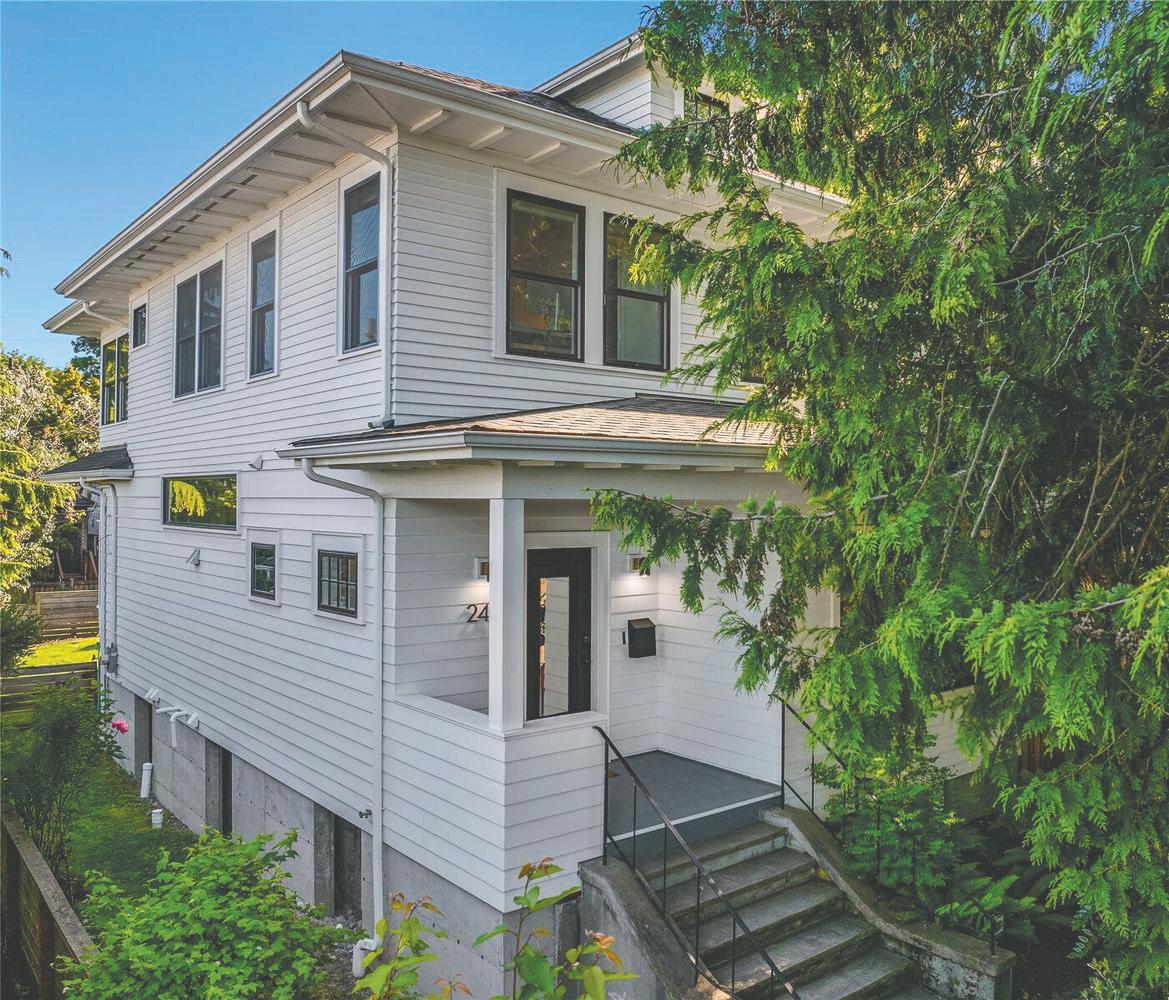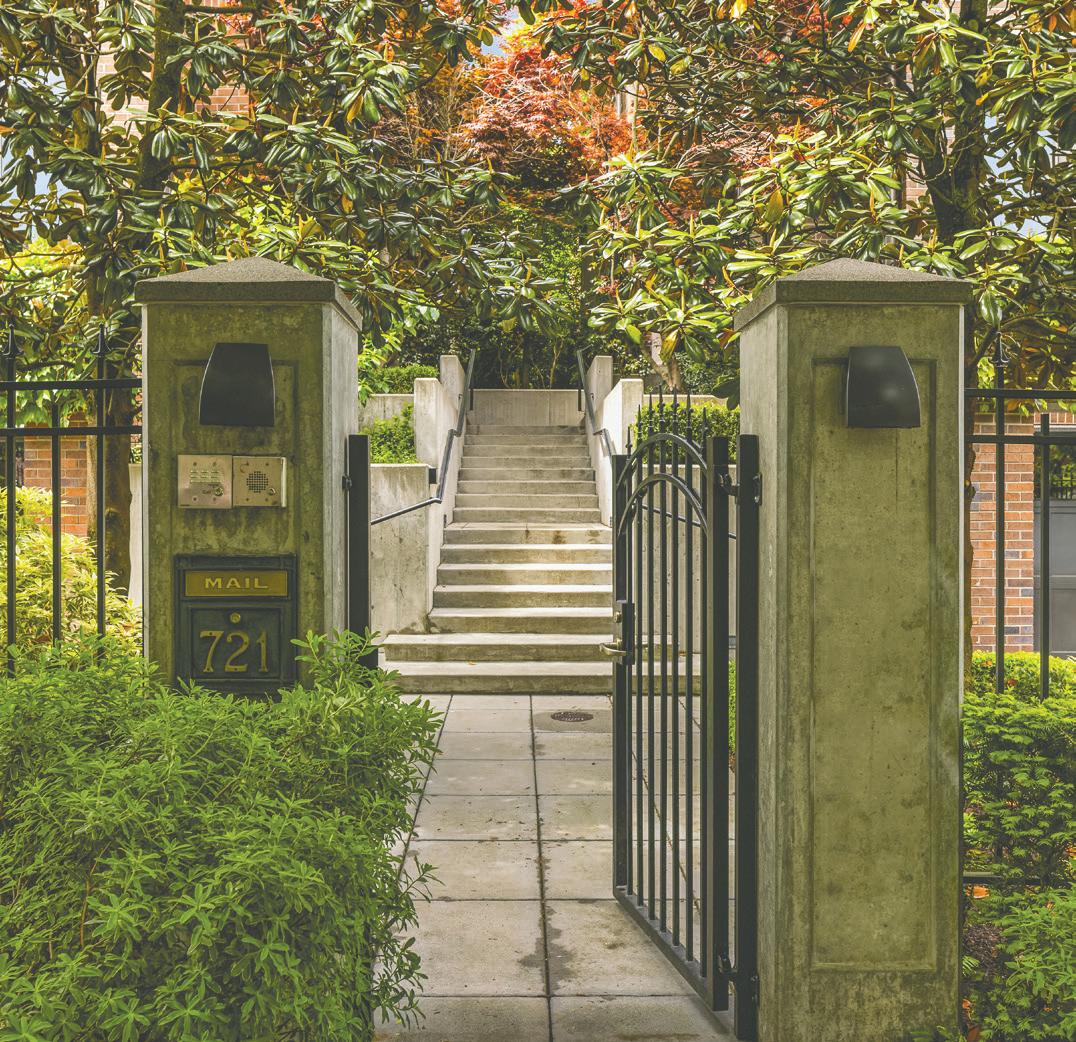

Madison Park Times
Summer is heating up in Madison Park
By Friends of Madison Park
Hard to believe we are already to August; the summer for Madison Park has been busier than ever and more events are on their way.
MUSIC IN THE PARK
The series begins Thursday, Aug. 7 with all new artists and runs every Thursday evening in August 6:30-8. The Music Factory will also have students and their musicians arriving at 6 to welcome the community with their musical set. Grab a picnic, a blanket and lawn chairs and come enjoy the best of the summer- just a walk away to our own music festival!
Aug. 7: Eden, featuring Savanna Woods
Aug. 14: Angela Soffe Band
Aug. 21: The Carlile Family Band (Brandi’s cousins)
Aug. 28: Neon Rain

5
The Children’s Parade and Picnic in July was a day of joy and games and so very many adorable children from the neighborhood.

Meet your neighbor: Mary Gonzalez
By Jenny Martin
This is the first feature in a new “Meet Your Neighbor” series designed to help you get to know one of the residents of Madison Park. Although Madison Park is a small community, it can sometimes feel large. To foster a stronger sense of community, this column will introduce you to your neighbors. After reading each edition, you’ll be able to put a name to a face and greet people like Mary when you see her walking by.
1. Please introduce yourself. How long have you lived in Madison Park? Why did you chose to live here?
Hi, my name is Mary Gonzalez, and I’m originally from Venezuela. I moved from Miami to Seattle in 2007 and settled in Madison Park in 2009. When I first arrived, I worked as a caregiver in Montlake and only knew how to drive between there and Madison Park. I used to bring a lovely lady to the lake and the nearby restaurants, and I fell in love with the area. I told her I wanted to live here one day, even though she said it was a place for rich people. In 2009, after getting my first job as an interpreter, I finally made Madison Park my home. I wasn’t rich, but I loved this

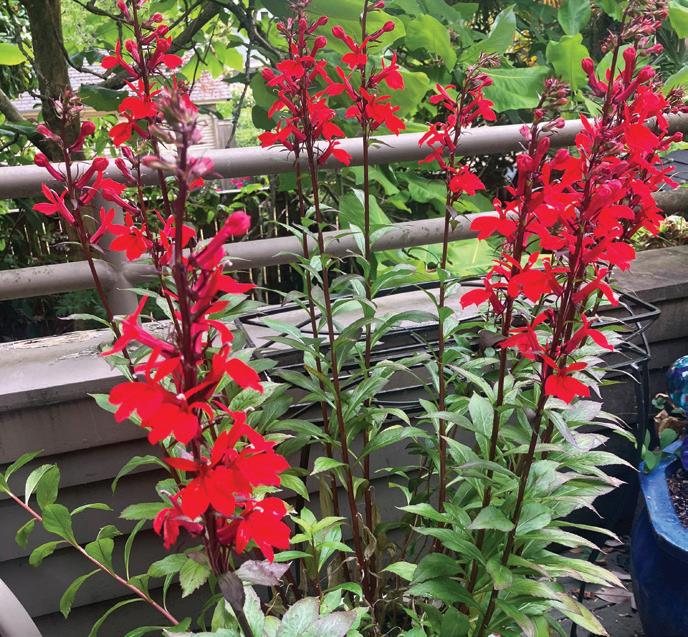




Mary Gonzalez
COURTESY
COURTESY PHOTOS

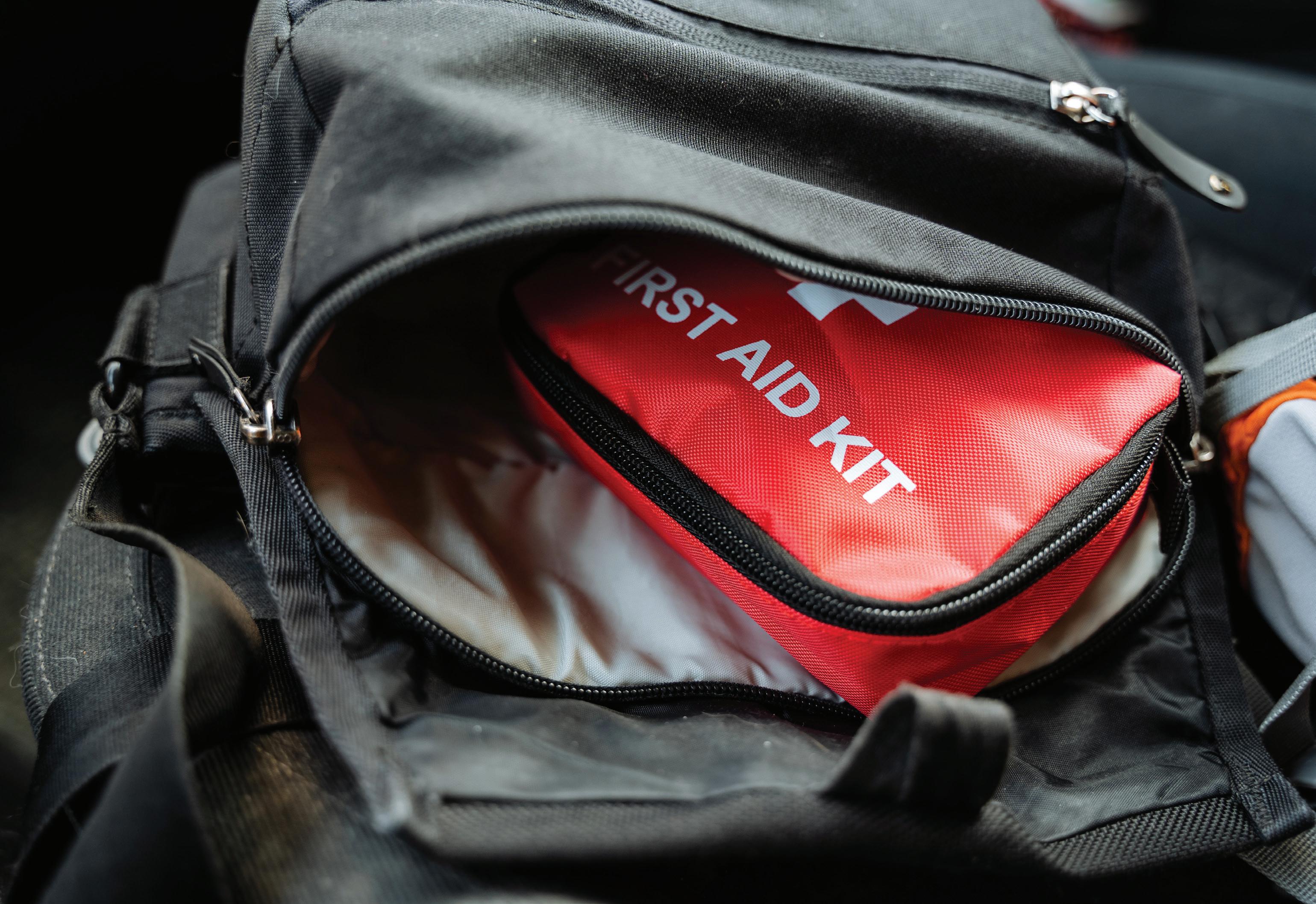
Button up your overcoat: Investing in everyday prep
Preparing for an outof-town trip recently, I went through the usual ritual of purging my purse of unnecessary items— and possible TSA contraband. In doing so, I ended up adding an item: a small Band-Aid kit. I’d recently cut a finger and was wearing a fingertip BandAid, which works better than a standard one and can be hard to find, so I made up a small bandage kit: a snack-sized Ziplock bag containing a knuckle BandAid, a fingertip Band-Aid, two regular Band-Aids, and a small package of “wound wipes.”
I was surprised I hadn’t thought to carry Band-Aids around regularly, since they take up next to no room and you don’t know when you (or someone else you know) will need one. And it made me think about what other kinds of things we could or should carry around every day that would help in an emergency. My purse already contains several versatile prep-type items, so I’ve got a good start on an EDC: I have a headlamp, a power bank (aka backup charger) with an “octopus” charging cable (so that I can charge my phone/iPad/ Kindle with just one cable), face masks (in a zippered bag I acquired in the pandemic), a large kerchief (for spills or to use as a “tablecloth” for snacks), the aforementioned small Band-Aid kit, and $20 or more in cash (not in my wallet, and intended only for “emergencies.”
However, as a prep enthusiast, I know I can do better. I do know I’d like to add a multipurpose tool (multitool) that

includes items like tweezers and scissors. What else could I add to my purse that wouldn’t take up too much space but would help me be readier for an emergency?
In the prep community, there’s a term for this: an Every Day Carry kit, or EDC. Whether it’s in your purse or backpack, you can create a useful EDC with just a few key items.
Every Day Carry (EDC) Basics
Most well-stocked EDCs, per my reading, often include (in addition to money and a power bank, which I definitely recommend) small versions of these items: a multitool, a light source, a lighter, a small pen, and a whistle. Sensible and intriguing, but seemed like a lot of research—and maybe a lot of money.
Then I ran across a video by The Urban Prepper (a Seattle local, and a good prep content creator): Budget Everyday Carry (EDC) Under $100. All the items he recommends cost a combined $100, so it seemed like just what I was looking for. I strongly recommend you watch his video (search that title in YouTube’s search box) to see what the items look like.
Here are my thoughts on the main items he includes (see the next section for a note on knives).
Multitool: Should be small
and not too fussy. The Urban Prepper recommends the Gerber Dime, an adorable tiny folded tool that includes pliers, wire cutters, a TSA-compliant blade, scissors, two screwdrivers, tweezers, a file, bottle opener, and a blade for cutting plastic packaging (my favorite part). This one’s available at REI and hardware stores, and is going to the top of my EDC wish list!
Light source: I still swear by headlamps as a post-earthquake necessity, but a handheld flashlight still has its uses (for instance, I keep one by the front door for late-night “what’s that sound outside?” outings. While the Urban Prepper recommends the USB-rechargeable Streamlight Microstream, I recommend the similar model that uses a single AAA battery, since electric power will be at a premium in an emergency. Any small flashlight would work, however (note that this one is no bigger than a cigar!).
Lighter: Although the prep community is fond of refillable and classy Zippo lighters, The Urban Prepper recommends a plain old plastic Bic. Effective, reliable, cheap, and available nearly everywhere.
Pen: A mini pen is great for leaving notes or writing things up (if cell phones run out of juice) and can fit almost anywhere. The Urban Prepper recommends the Pentel Mini RSVP pen. It’s wee! Whistle: For the morbid possibility of being trapped somewhere you need to be found. Your standard referee-style whistle is inexpensive and would work fine (and most have a cord,
for easy carry around the neck), but The Urban Prepper recommends a cute mini whistle by Noopel.
Other items to consider (from various prep resources, including the EDC community on Reddit): a baggie containing a few sheets of toilet paper and portable toilet wipes, some sheets of duct tape—preppers often wrap them around something else in their kit, like an old credit card or the aforementioned Bic lighter, and optionally a length of paracord (lightweight, durable nylon cord with a variety of emergency uses).
Storing your EDC: Ideally, you’d want to store your EDC items together so they are protected and can easily be found.
The Urban Prepper recommended using a small dedicated pouch to keep the EDC organized. One prepper recommended using a glasses case, which makes sense—I always have extras lying around and they are designed to protect the items in them!
WHAT NOT TO INCLUDE IN YOUR EDC
A knife: Although many preppers recommend a knife as part of your EDC (and it’s the first item in the video I cite), recent Washington state law on the possession of weapons in certain public spaces (like transit stations, libraries, and zoos/aquariums) is muddy, so I recommend steering clear of keeping a knife in your EDC—though naturally, a knife is a solid addition to your home survival kit, if you make one.
A survival bracelet: Before I started this research, I lusted
after—and planned to recommend—a “survival bracelet” for EDC. This bracelet is made of braided paracord and can be disassembled into a long and strong cord (useful for converting a tarp into a tent, among other things). It comes in different styles and colors and usually includes other accessories like a compass, firestarter, whistle and more.
But The Urban Prepper has never heard tell of any preppers unwinding the cord from the bracelet, and said they’re more of a “friendship bracelet” for preppers than anything else. His observation (and others in his Overrated EDC Items video) helped me decide to avoid “fun gadgets” for my kit and stick to practical, inexpensive ones. (His video also mentions skipping fancy wallet/carabiner tools and mini-pry bars.)
As always, this column is part of Madison Park Emergency Hub’s outreach effort. We’re an all-volunteer organization focused on neighbors helping each other after a disaster. To get on our mailing list, contact us at madparkhub@gmail.com.
Come see how we plan to help neighbors help each other in an emergency at our Hub Show and Tell Drill at the Madison Park tennis courts on Saturday, Aug. 16 from 1-4 p.m.
ADOBE
Dana Armstrong
Riding the hydrangea rainbow: Changing flower colors
The beautiful, vast and storied clan of hydrangeas is full of mysteries. Judging by the annual flood of questions in social media gardening forums, it’s one of the most confounding groups in the plant kingdom. I could write a year of columns alone on identifying varieties and pruning strategies.
Today, however, let’s tackle the most fun hydrangea question of them all – how to harness the kaleidoscopic power some hydrangeas must shift color.
Has this happened to you? You buy a hydrangea with a glowing blue or purple blossom on the plant tag, that in your yard, blooms some version of pink – blush, raspberry, or magenta. Then you pass a hydrangea in your travels that is almost surreal – a deep violet color, recalling royal cloaks of old in ermine and velvet. You wonder, can your pink hydrangea be coaxed to this magical feat?
Let’s find out.
Not all hydrangeas change color
So, first things first. Although the hydrangea family is vast, some hydrangeas have this superpower, some don’t. These are: Hydrangea macrophylla (bigleaf hydrangea) and Hydrangea serrata (lace-cap
A

hydrangea). They flower in either blue or pink, ranging from pale sky or blush to violet and magenta.
According to Master Gardener Mary Jane Duford, (https://homefortheharvest.com/hydrangea-colorchart/) some cultivars seem more amenable to “bluing,” because they release more citric acid, opening the way to absorbing aluminum). Others, like ‘Summer Crush,’ tend to stay pinker despite lower pH levels.
White-flowered hydrangeas, although oak-leaf and panicle hydrangeas may morph to pink as the blossom ages but won’t change their initial blossom color.
Also important: you can’t make a pale-flowered variety vivid. Each plant has built-in pigments and there’s a limit to how much aluminum it can absorb. So, blush may shift to sky blue, but not magenta or violet.
What causes the color shift?
The magic lies in the pH of the soil and how that affects the availability of aluminum. Aluminum becomes more available in acidic soils – those with of 6.5 and below.
For blue flowers, you’ll need soil with a pH of 5.5 or lower, purple comes in at 5.5 -6.5, and pink is above 6.5.
CHECK YOUR SOIL
Use a pH testing kit to measure your soil around your hydrangea in several places. I like the kinds with metal rods that also measure soil moisture or temperature.
Before you try to change your soil’s chemistry (which will affect surrounding plants as well), there are a few reasons you may not want to change your soil pH.
For example, Duford writes (https://homefortheharvest.com/ hydrangea-color-chart/) that a range of 5.5-6.5 is ideal for overall nutrient absorption and plant health.
Also, the change isn’t instant or permanent. Think of it as semi-permanent hair dye – you may need to apply every two months for up two growing seasons to see results. Ongoing touchups will be necessary.
Remember, the soil in an open garden bed is a living system connected
to water, microbes, wildlife, and plants. That’s why you might see a single hydrangea producing both pink and blue blossoms - like mine did after I added aluminum sulfate once.
ADJUSTING HYDRANGEA COLOR
If you do want to change your hydrangeas, measure your current pH. For bluer and more violet tones, add aluminum sulfate. Make sure not to over-fertilize otherwise, because high levels of phosphorus can prevent aluminum uptake. Garden Design magazine recommends (https:// www.gardendesign.com/hydrangea/ how-to-change-color.html ) shooting for low phosphorus, moderate nitrogen, and high potassium. For pink tones, add garden lime while maintaining high nitrogen and low phosphorus. Garden Design suggests applying in fall and early spring. Always follow directions, don’t allow the amendment near the plant crown, underapply when in doubt, and water in well. You’ll likely need to do it over a couple of years and then reapply if it starts reverting.

Although the hydrangea family is vast, some hydrangeas have this superpower, some don’t. These are: Hydrangea macrophylla (bigleaf hydrangea) and Hydrangea serrata (lace-cap hydrangea). They flower in either blue or pink, ranging from pale sky or blush to violet and magenta.
If you’re thinking this sounds like a lot of work – it is! You may decide it’s not worth it for in-ground plants, especially if you prefer working with natural conditions and creating a resilient, low-input garden. Instead, try your color-changing experiment in a container. Potting mixes usually fall in the 5.5-7.0 pH range (again, measure to confirm), and it’s easier to control condition. You’ll use fewer inputs, see results faster, and protect the integrity of your garden’s soil and groundwater.
small, but not slight, sense of
community

Mary Lou Sanelli
The summer I was 17, my mother took me to a hair salon for the first time. Until then, she’d always trim my hair. But the summer I was 17 was the summer before I was to leave for college, and in every way, it felt like everything needed to be different. I’d grown accustomed to being treated with impatience if I fidgeted when my mother cut my hair, but at the salon, I was someone else, more adult. I was not big on looking particularly feminine in those days. I was a tom-boy. And I liked being a tom-boy, but not nearly as much as I wanted to be accepted at college. She combed my hair to one side and then the other, studied the length of my bangs. I was awed: Could there really be someone so understanding as to know just how important this haircut was? She gave me a feathered shag.
If you have never seen a famous actress flip her feathered layers while flashing a bleached-white smile; if you have never watched someone move her curtain bangs
to the side with her index finger in a way that seemed not just alluring but illuminating, then you might not understand how much that feathered shag meant to me then.
But watching the hairdresser work had a powerful influence on me that, surprisingly, had nothing to do with envy. It made me want what the hairdresser seemed to possess, a profession that went with the woman I wanted to grow into: one who knew herself well and enjoyed what she did.
I’m remembering all this now because this afternoon, I’m off to the hair salon again. I’m happy I need a haircut, anything to break up my morning of writing (the best part), catching up on emails, doing laundry, because I can honestly say that I welcome any enjoyable break from routine, especially in summer, and I’ll think the same thing I’ve thought every time I walk through the salon door: I’m so glad I found this place.
In my stylist’s chair, I’m the older one now, and it’s me listening to lend support. She is 20-something and I’m always reminded how much of the really big, if a little predictable, stuff happens in our 20s.
I’ve delighted in her wedding plans, first baby stories, first-time home owner joys and woes. My own life hums along in comparison, nothing all that spinetingling, few firsts, unless you count trying to cook. But

I like it. I like the idea that I’ve worked so hard for so long, that the big part of me that chased every opportunity floats further and further away.
Sometimes I sip my coffee in lieu of speaking because I am afraid that something motherly will spring from my lips and I’ll say something too protective like: “Are you sure you want to make that decision, sweetie?” But it’s too much to contribute. Instead, I say, “Good for you!” Because whatever I might think I know about what is best for anyone else, I’m surely so far off; hindered by my own fears and shortcomings.
Here’s another thing I delight in: Before either of us share something personal, we do the look-round: Before you say anything, you look all around to make sure there is no one too close. Even on the ferry, my friends and I do this. One time, another stylist, also in her 20s, spoke about a client that did something that hairdressers must just hate: she didn’t show up for her appointment. What made me chuckle to myself was that, attempting sympathy, she said the woman was old and likely just forgot. I heard it as she meant it, as both an annoyance and an inevitability. I also recognized the no show’s name, she lives in my building. And I’m pretty sure she is younger than I am. The stylist hadn’t
meant to be insensitive. To her it was simply the truth. And brace yourself, to these women, it is, says the voice in my head, and I know she is right. A thought I might not have bothered to share before, because I don’t wish for anyone over 50 to see themselves through 20-yearold eyes because to a 20-year-old you are ancient at 40.
After my cut, my stylist sweeps up the hair that circles my chair. Other than manage all of us “old” women, one after another, this is what they have to do a lot — just sweep. At one point, in one of those perfect moments when my affectionate eyes meet hers, it’s so intimate and real that I will inevitably leave a great tip, lean forward before leaving so that our foreheads will touch ever so slightly or we may even hug.
As I leave the salon, I know I will write a story about today but I’m pretty sure it won’t end up anything like the way I intended, my subconscious will inevitably see things I didn’t know I saw. But the way I will write it is something I can already feel: a small, but not slight, sense of community I will walk home with today. And it will carry me.
Mary Lou Sanelli’s latest title is In So Many Words. She works as a writer, speaker, and master dance teacher. For more information visit www.marylousanelli.com.

Erica Browne Grivas Get Growing
ERICA BROWNE GRIVAS

Expand your grilling horizons
By MetroCreative
Grillmasters are always looking to push the envelope and expand their grilling horizons. While standard fare like hot dogs and hamburgers will always find its way onto a backyard barbecue’s menu, some grillmasters prefer to try new things and surprise their friends and family members along the way.
Ambitious grillmasters hoping to surprise their guests should consider the following recipe for “Grilled Herb-Rubbed Game Birds” from Peggy Knickerbocker’s “Simple Soirees” (Stewart, Tabori & Chang).
GRILLED HERB-RUBBED GAME BIRDS
Serves 6
Ingredients
■ 6 game hens, squab, or poussins, cut in half
■ 1 teaspoon salt
Ingredients for the marinade
■ 3 cloves garlic, minced
■ ¼ teaspoon salt
■ ¼ teaspoon freshly ground black pepper
■ ¼ cup chopped fresh thyme or rosemary leaves
■ 3 tablespoons extra-virgin olive oil
■ Pinch of crushed red pepper flakes, optional
■ Herb sprigs for garnish
Directions
Pat the birds dry and season them generously with salt. In a small bowl, stir together the garlic, salt, pepper, thyme, olive oil, and red pepper flakes.
Do not rinse the salt from the birds, but make sure they are very dry, pat with paper

towels. The secret to crispness is very dry skin. Stuff a little of the marinade under the skin of the birds and rub the rest on the outside.
Cover, refrigerate and marinate the birds for 30 minutes or overnight. Save any remaining marinade. Prepare a charcoal fire or preheat a gas grill to medium. When the
coals are medium-hot, place the birds on the grill, skin-side down.
Cook for about 15 minutes, until they are brown and crisp. Turn and continue to cook for another 15 to 20 minutes, brushing with a little of the remaining marinade.
To check for doneness, make an incision at the point where the thigh meets the body of
the bird, if the juices run clear and there is no visible redness, take them off the grill.
Smaller birds will take a little less time, about 15 minutes on the skin side and only about 10 minutes once flipped. Transfer the birds to a warm platter and scatter a few sprigs of herbs over the tops.
Snap out of it: Reset your nervous system now
“Snap out of it!” yells Cher in “Moonstruck” when Nicholas Cage says he loves her. Even though she slapped him – twice – it had little effect, to the delight of movie fans and romantics. Come to think of it, does that ever work when someone tells us to “Just relax,” or “Snap out of it?” Rarely, in my experience.
My guess is this is because we likely resent being told what to do – especially when we’re feeling overwhelmed. But what if the message came from us ?
When our sympathetic nervous system is being triggered, it’s very important to stop that train before it begins gathering steam



– affecting our emotions, our body, our day, and eventually, our health.
The good news: there are some clever but simple tricks we can do to short-circuit that response. London-based hypnotherapist Adam Cumberland offers several.
Most of these involve tricking the brain or stimulating the vagus nerve, which work in tandem to regulate the nervous system between sympathetic (fight/flight) and parasympathetic (rest/digest) to get you back on track.
Our goal is to get out of our heads, derail spiraling thoughts, and reconnect with our bodies to reset and gain a new perspective.
They are:
The Cold Snap. Hold something cold (your water bottle or an ice pack) in your palm for 10 seconds. This works to shift attention from racing thoughts to the body, so your brain is thinking, “Why the heck is my hand so cold?” Others have suggested plunging your hand in ice cubes, taking a cold shower, or splashing your face with very cold water.
The Gaze Break. Feeling stuck in a situation? Raise your eyes to the ceiling for five seconds or more. In times of stress, our eyes become hyper focused locally, getting tunnel vision. Looking upward tells our body we must be ok, because we can look up. Hypnotists often

use eye movement as part of trance induction. In fact, they’ll test if someone can hold their gaze upward toward the forehead—a sign they’re open to suggestion. Similarly, EMDR (Eye Movement Desensitization and Reprocessing), a trauma therapy gaining popularity, uses eye tracking to support emotional processing.
MUSCLE RESET
Clench your fists and mimic a bicep curl, holding tension for 30 seconds and release. The instant relief of tension and warm blood rushing to your arm cues relaxation. Extra tip: if you really want to relax, or need help sleeping, try a progressive muscle release and do your whole body from toes to neck.
OPPOSITE VOICE
This one reminds me of Joe Dispenza’s meditations. In recent
years, he’s adopted an eccentric tone and unpredictable rhythm in his recordings—often off-putting to new listeners. But there’s a reason: by keeping your brain slightly disoriented, it can’t anticipate every word and spin its usual stories. For this reset, you’ll take charge of your negative thoughts. The way you do it is: pick the negative thought that’s plaguing you and say it in the silliest cartoon voice you can muster. This takes the emotional sting away from the thought, creating space to question it. Humor is a wonderful pattern-interrupt.
NON-DOMINANT HAND
Using your non-dominant hand, write your full name slowly. Similar to the above reset, it jars the brain out of autopilot, engaging executive function and curiousity. Try this other fun application from author Jim Quik. Brush your teeth
with your non-dominant hand to keep your brain sharp.
MIRROR BREAK
Make eye contact with yourself in the mirror for at least 20 seconds. It should anchor you in the present moment and engage your empathy. Bonus points: Mel Robbins suggests high fiving yourself every time you see your reflection. It may feel silly, but it’s said to improve positive self-image over time.
FAST FORWARD
While tapping your wrist like you would a watch, ask yourself “Will I care about this in five years?” This shifts your perspective through time, lightening the emotional charge of the current moment. I wonder if the tapping ties into EFT – Emotional Freedom Tapping – which hits acupressure points as you reframe difficult concepts. (Note: the EFT wrist point is on the underside of the wrist.) These techniques aren’t meant to bypass deeper healing work, but they can interrupt cycles of distress and offer a reset when you need it most. Experiment and see which ones feel right for you. The more tools you have, the easier it becomes to “snap out of it”—on your terms.
Erica Browne Grivas Your Best Life

EVENTS
From page 1
Thanks so very much to all our wonderful Sponsors: Parkshore Residential Association, Aegis Living, Cactus Restaurant, Windermere Madison Park, Coldwell Banker Bain, Wicklund Real Estate, The Attic and The Music Factory!
PARTY FOR THE PARK IS BACK
Join us Sept. 13 at 6:30 p.m. for Party For the Park at the Broadmoor Golf Club to celebrate our community, our neighbors and all that Friends of Madison Park weaves together through events, projects and volunteers coming together.
This year’s event will feature hors d’oeuvres, cocktails, silent & live auction, games, short program, and live music by the Jenning’s Duo, a musical couple from right here in Madison Park, followed by dancing.
Help us raise funds for the free community events, neighborhood beautification efforts, and the beginnings of our legacy project- The Bathhouse Renovation and Beach Restoration project. Tickets will go fast so grab yours now! $150 per person and can be purchased on our website at www.friendsofmadisonpark.com/partyforthepark.
This evening would not happen without the Huge Support of this year’s Sponsors: Explora Journeys, Woodside Travel, Compass Real Estate- Bennion, Snyder, Hosford, CATS Child and Teen Solutions, Walter F. Toth Construction, Jansen, Kaleidoscope, Inc., Silk Cavassa Marchetti Architecture & Interiors, NW Mechanical, Ballast Architects, Cambium Landscape and JAS Design Build. Thank you so much!
THE FARMER’S MARKET
The market has gotten off to a wonderfully successful start this summer- with a steady stream of neighbors visiting friends, gathering fresh produce, salmon, berries and more in their shopping bags and enjoying the sense of community the market creates. The Seattle Farmer’s Market
NEIGHBOR
From page 1
Maya and Bonbon, to join me. They quickly became part of the community. Sometimes, their loud and joyful personalities drew some attention, so I’d explain, “Sorry, they’re Latin dogs!!”
I think they were better known than I was; everyone loved to pet them and showed compassion when Bonbon passed.
2. What is your profession and why do you love the work you do?
I am a Spanish-English interpreter and translator. In Miami everyone speaks Spanish, so there was no need for my services.
However, when I moved to Seattle at age 62, I found my skills in demand. I quickly applied for the WA Medical/Interpreter certification and, upon passing the exam, began freelance work as a medical interpreter. Soon after, I joined the King County Health Department, where I worked in various health and dental clinics for 13 years.
For me, it has been more than just a job; it has been a privilege to assist non-English speaking patients. Whether at medical appointments or during home visits with nurses, I feel fulfilled in helping them navigate both the healthcare system and the cultural differences they encounter. The patients at King County often
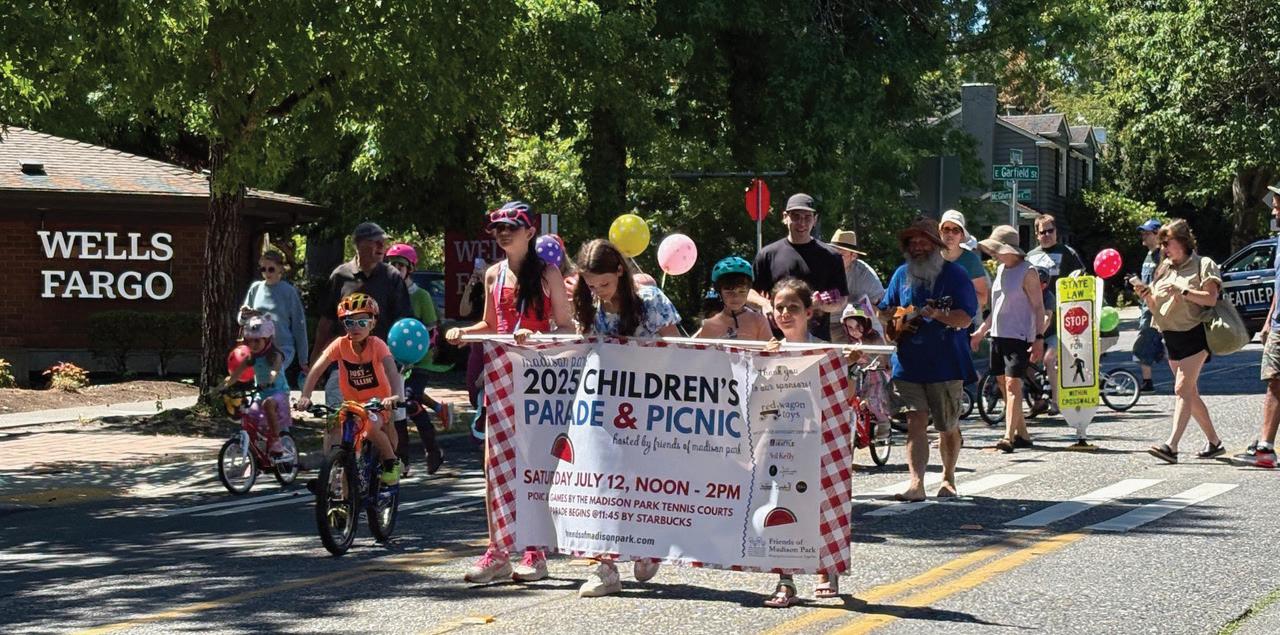
The Children’s Parade and Picnic in July was a day of joy and games and so very many
neighborhood.
Association says the turnout and success has far exceeded their expectations, the vendors are thrilled and so happy to be in Madison Park. Feedback from our local business has been positive as well. We have added a short survey on our website under Farmers Market banner at www.friendsofmadisonpark.com. Please take a moment and fill it out.
Plan ahead for the Fall.
UPCOMING
The Annual Art Walk, sponsored by Home Street Bank will take place Friday, Sept. 12 starting at 5 p.m. Stroll the businesses and enjoy wine, treats, music and a wonderful array of artists.
Little Beats Concerts will begin Oct. 4 and run every first Saturday of the month through March at The Pioneer Hall 11 a.m. to noon. Many new performers this year and the perfect Saturday morning activity with your little ones through the Fall and Winter. Only $5/ticket. Tickets go on sale in August.
Neighborhood Meeting Schedule:
We have needed to make a couple of changes with the Fall meeting schedule so please mark your calendars. Meetings at the Bathhouse at 7 p.m.
Tuesday, Sept. 9: Meeting postponed
Tuesday, Sept. 30: Meet with City Council Member Joy Hollingsworth
Tuesday, Oct. 14: Meet with the Bathhouse Renovation and Beach Restoration team
Tuesday, Nov. 11: General Neighborhood Meeting
In case you missed it, the Children’s Parade and Picnic in July was a day of joy and games and so very many adorable children from the neighborhood. Just a few pictures capture the moments, and you can view our video at https://
come from diverse Latin American backgrounds, and I am grateful for the mutual support we share.
3. Do you have plans to retire?
This question is so funny! At 82, you might think I should already be enjoying retirement, right?
Well, I actually retired from King County two years ago, but I still pick up shifts at the same clinics where I used to work. Whenever they need someone to cover for vacations or sick leaves among their interpreters, I gladly step in. It brings me so much joy to see familiar doctors and sometimes the same patients. They all seem so happy to see me again, which makes it hard for me to consider a full retirement—at least for now!
4. What keeps you motivated in your life?
Really that I can get up every morning and know that I am still able to help other people also that I am alive and that with the help, of God I can continue doing something worthwhile for someone every day.
5. Please share a particularly challenging period in your life and how you overcame it.
When I moved here to Seattle at the age of 62, I did not know anyone, and it was a point of no return. In 2008, during the crisis, I had no choice but to leave Miami,
so I told myself I had to make it work here. By chance, I met a wonderful woman named Amparo, who was originally from Colombia and had lived in Venezuela before settling in Seattle. She took me under her wing, becoming my guiding light in this new city.
Amparo was my hands and feet, helping me navigate through the challenges. And besides telling me to buy a raincoat since it seemed to rain every day, she provided me with love, support, and companionship, patiently showing me how life worked in Seattle. She offered her shoulder to cry on during my tough days and uplifted my spirits through the dark moments of my first winter here. I truly believe she was an angel sent by God.
I lived one day at a time; at that time I could hardly make it 24 hours but I did.
6. Can you tell me about a person that influenced the course of your life and how?
I think my mother was the main influence that I had, her resilience and courage with 7 kids, the way she always was positive in the worst scenarios gave me that inner strength. She left Venezuela 50 or 60 years ago and with limited financial help took us to New London Connecticut so that we could learn English, see this beautiful country and become people of integrity who could give back to others.

www.youtube.com/watch?v=ewNtyYaJklU. Please remember, we always need volunteers for our events and projects. Truly you get back so much, meet wonderful neighbors and just have a lot of fun, working to make our community healthy and vibrant. Check out opportunities on our website at www.friendsofmadisonpark. com/volunteer.

Mary Gonzalez
7. What are some of the happiest moments you have experienced? What made them so memorable? One of the happiest moments I’ve experienced, especially during my new adventure in this wonderful country, was when I finally settled in Seattle and my son brought over my two adorable Yorkies, Maya and Bonbon. I had to leave them behind when I moved, so that moment when I had them back again filled my heart with joy and was a super memorable moment.
8.What small moments bring you happiness each day?
When I wake up and give thanks for my health, for the opportunity that I can still work, and that my work means helping another person and still get paid for it!! And like today walking in this beautiful neighborhood, sitting in front of the lake and sometimes even able to see Mount Rainer, what else can I ask! I am blessed in the place I live and in this wonderful community where a Good Morning from someone that goes by, going to Park Postal and getting such a big smile there from the staff, it makes my everyday feel meaningful!
COURTESY PHOTOS
adorable children from the
COURTESY PHOTOS

Music in the Arboretum returns in August
Staff Reports
Music in the Arboretum returns in August with two free, outdoor performances at Washington Park Arboretum.
Ben Hunter & The Intraterrestrials will share folk music from the Black diaspora from 6-8 p.m. Wednesday, Aug. 13.
Jose Gonzales Trio will perform creative, bluesy variations on jazz favorites from 6-8 p.m. Wednesday, Aug. 20. The trio features the talented jazz pianist and Seattle Japanese Garden horticulturist Jose Gonzales. All ages are welcome.
Performances will take place at the Graham Visitors Center in the Arboretum, 2300 Arboretum Dr. A limited number of seats will be provided. Attendees are encouraged to bring folding chairs, a cushion or blanket.
Parking is free, but spaces are also limited. Attendees are encouraged to carpool or come by foot, bicycle, or public transportation.
For information, email info@arboretumfoundation.org or call 206-325-4510. To RSVP, visit arboretumfoundation.org/ events/music-in-the-arboretum.
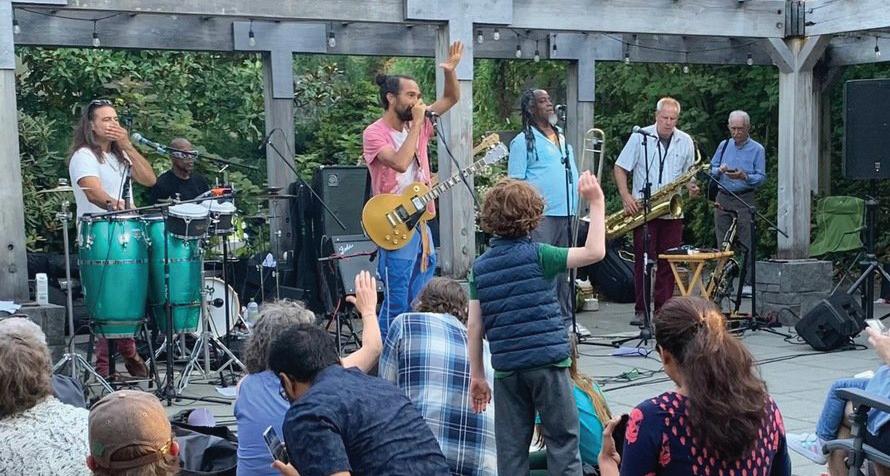
Thank you to Domicile Gallery
I am writing as a former resident of Washington Park for 18 years and a current resident of Madrona. I am also an artist. I have had the honor of exhibiting my work at the Domicile Gallery three times, twice as a solo exhibitor. As I have been lucky to show my artwork in many galleries over the years, I am struck by how inviting and joyful the opening receptions are at the Domicile Gallery. It is truly a community building event with friends old and new.
The owner of the gallery, Marisa Spooner- LeDuff, has done a fantastic job in creating a friendly space for neighbors to gather as well as a credible showroom for professional artists to sell their work. As a resident and as a painter, I am truly grateful to Marisa and to her assistant Hannah for all of their hard-work and dedication to the betterment of the Madison Park community. Thank you and keep up the awesome work.
Jamie Rawding




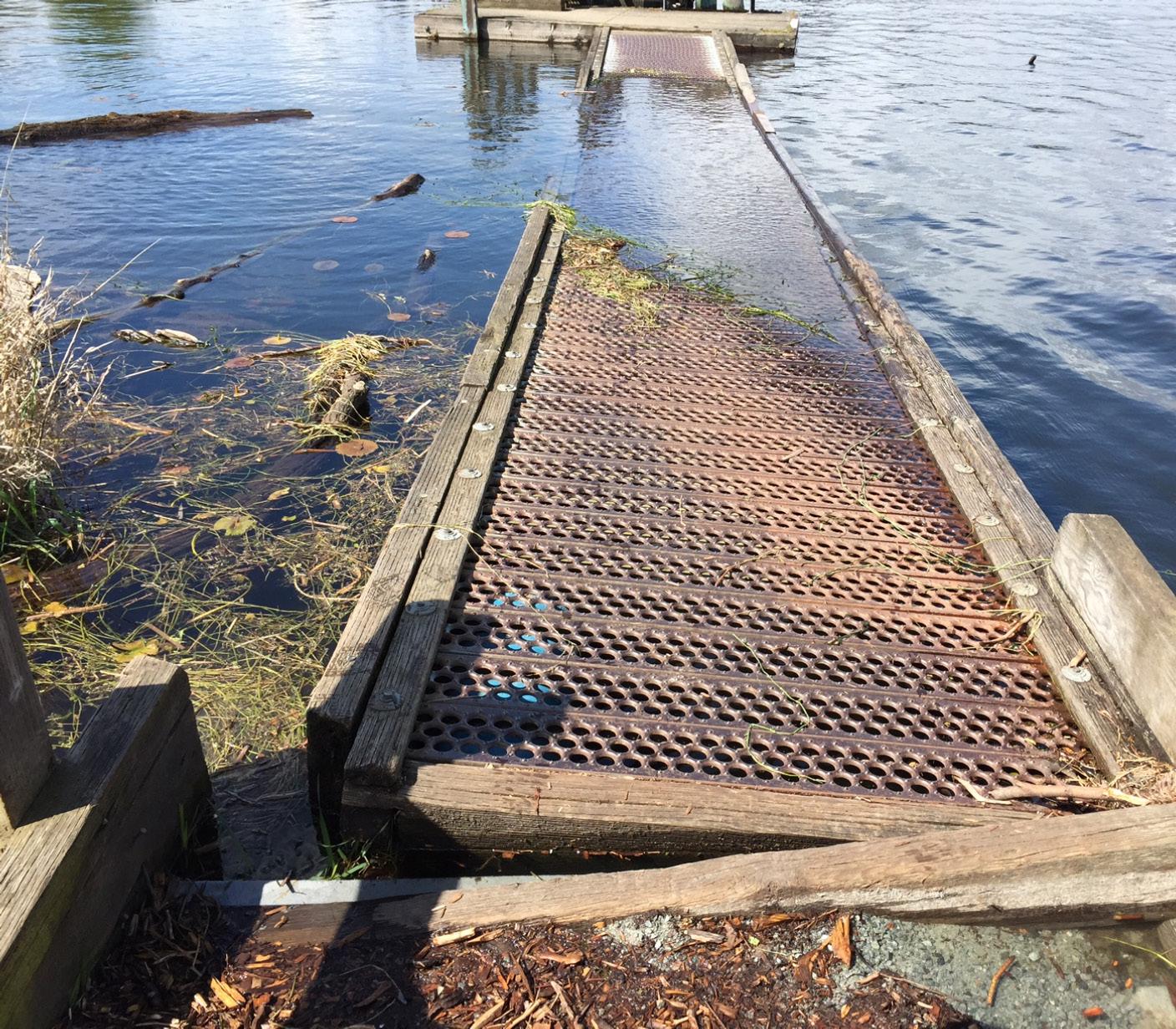
Seattle’s Arboretum Waterfront Trail set for major repairs
Relief is on the way for walkers, joggers, and anyone navigating Seattle’s Washington Park Arboretum Waterfront Trail: A long-awaited improvement project is finally underway to address years of wear and tear on the scenic boardwalk.
Seattle Parks and Recreation has launched a $2.45 million upgrade project to rehabilitate the trail’s Foster Island section, which includes portions of the path that float above wetlands. Planned improvements include new boardwalk decking, upgraded drainage, improved slope grading, and accessibility enhancements for all users — including those with strollers, wheelchairs or other mobility devices.
The project will also address sections of the adjacent gravel trail that have become increasingly difficult to navigate.
Though delays in securing state and federal permits slowed design work, Phase 1 is now ready to move into bidding and construction. The project also received funding from the Seattle Parks District to begin design work for Phase 2 on Marsh Island. Seattle Parks is currently hiring a consultant and conducting site surveys for the next phase.
A timeline for groundbreaking or project completion has not yet been set.
The Arboretum will remain open throughout construction, though temporary trail closures or rerouting may occur, depending on weather conditions, equipment scheduling or other factors, according to the city.
Once complete, the renovated trail is expected to preserve its scenic views of Union Bay and local wildlife, while offering a safer and more accessible experience for all visitors.
Staff Report
Music in the Arboretum returns in August with two free, outdoor performances at Washington Park Arboretum.
COURTESY

Swamp in a Pot
Eureka! If you heard that shouted out about three years ago in July, in Madison Park, it was me. After decades of struggle, I’d finally figured out how to sustain the beauty of Lobelia through the heat and drought of our summers. I call the system, Swamp in a Pot.
The statuesque and long blooming American native, Lobelia cardinals, had been a favorite of mine. The trouble was, we’d have a hot, dry summer day and, unless the plant was standing in close to soggy soil, it would flop to the ground. A flooding would get it back up, but the blooms where somewhat compromised thereafter. I was about to swear off Lobelia, figuring it was plain temperamental. Wrong. I just didn’t understand its needs. I’d been attempting to grow a bullrush in the Mojave Desert. What triggered
this epiphany was a trip to the Chelsea Garden Show in London. There I saw Lobelia ‘Queen Victoria,’ contained in a sunken pot, emerging from the waters of a fish pond. Interestingly, the huge fern Osmunda regalis was being used similarly, in another display garden.
Ah ha! Methinks, I can replicate that in Seattle. I’ll get a big pot, plug up the drain hole and grow Lobelia in standing water. I came home, potted up the plant you see pictured (Lobelia ‘Starship Scarlet’) in a large glazed container. I irrigated the plant so that it stood in water, above the soil line, to the top of the pot. The plant flourished. Straight, tall black stems stretched up, lined with handsomely toothed dark
green leaves. Then, in mid-July, like lava steadily oozing from a volcano, brilliant red blossoms started opening. The spectacle continued into October.
I cut the plant back with the first frost and turned the pot on its side to dry out the soil for the winter. The contained Lobelia has now survived two winters. It performs beautifully to this day. Next spring, I plan to extract the plant, divide it and repot it with fresh soil. But to this point, not a sniff of sour soil. One bonus of the system is that I can go away for several days and return to a happy, upright, fully quenched plant.
To securely close the drain hole, I used a square of duct tape, over the hole inside the clean, dry, empty pot. Then, I turned it upside down and, lighted candle in hand, dripped wax into the hole until it was full. I filled the pot and planted
the Lobelia. There’s never been a leak and the pot is not permanently sealed. I can open the drain hole anytime and use the container as it was designed.
Of the 375 species of Lobelia (including herbs, shrubs and even trees), the upright, long blooming perennials are the most well-known. The American native Lobelia cardinals, native from New Brunswick to Minnesota and south to Florida and across through Texas, is one of the parents of many of the newly introduced and vigorously flowering hybrids. Introduced into British horticulture in 1626, it is beloved in England and has been grown, propagated, cross pollinated and refined for centuries now. Lobelia fulgens, L. splendens and, most frequently, L. syphilitica have been cross bred with the American native. These horticultural love affairs have produced many interesting
offspring, like the vaunted L. ‘Queen Victoria’ with its rigid stems sheathed in burgundy red leaves topped with spikes of vivd red flowers.
In addition to beauty, the aforementioned Lobelia species have an ecological bonus. Like cattails, Redtwig dogwoods, and other plants, they can be used in rain gardens helping to purify runoff water.
So there you have it, advice for the less than micro-managing, hyper-controlling gardener. You can successfully have various pots of handsomely tall, perennial Lobelia, sans the need of constant watering or frequent frustration. I have three different named varieties in three different swamp pots on my deck. Robust and floriferous, I look at them daily and shout: Eureka!
Steve Lorton Tree Talk
Steve Lorton’s Lobelia in bloom.
COURTESY MARY HENRY




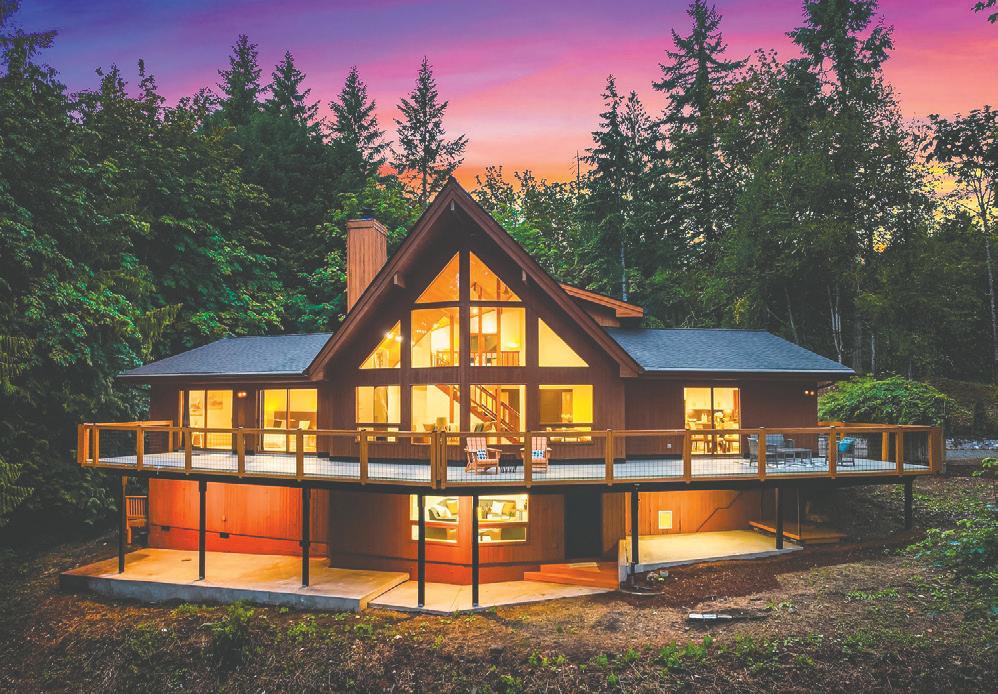








As we move through the third quarter of 2025, questions about the current state of the housing market and what lies ahead are top of mind for many homeowners and prospective buyers.

Having spent my early career as a CPA and CFO, I have long valued data as a guiding tool in nav-igating the complexities of residential real estate. While experience and historical trends remain im-portant, today's consumers are increasingly seeking real-time insights, especially those actively buying or selling.
To that end, the Northwest Multiple Listing Service (NWMLS) recently introduced a valuable new layer of data, collected at the point a listing goes under contract. This includes unpublished pending prices, the presence of multiple offers, use of escalation clauses, and whether financing or inspec-tion contingencies are included. While the specifics are not made public, the aggregated data pro-vides a more nuanced, timely picture of market conditions.
A Look at 98112 So Far This Year
As of July 29, 2025, the median unpublished pending sale price in ZIP code 98112 sits at an impressive $1.84 million, making it one of the
most expensive neighborhoods in Seattle. For context, the median pending price in 98105 is $1.273 million, and in 98109, $1.45 million.
Contrary to broader narratives of a “softening” market, the local picture in 98112 tells a more balanced story. Inventory has indeed increased, and price reductions are more common, but buyer activity remains robust. Over the past seven days, NWMLS-wide data shows 2,162 new listings, 1,619 closed sales, and 2,108 price reductions. By comparison, 98112 saw 8 new list-ings, 13 homes go pending, 6 closed sales, and 7 price reductions - suggesting that the pending-to-active ratio here remains stronger than the MLS at large.
While price reductions are part of the current climate, many properties in 98112 still receive multi-ple offers and sell at or above asking price. Year to date, the median ratio of list to pending sale price in our neighborhood is holding firm at 100%. This reflects a spectrum of pricing strategies: some sellers are listing accurately and attracting competitive offers, while others are pricing based on outdated expectations and are subsequently forced to reduce.
Notably, 33% of pending sales this year in 98112 involved multiple offers, and 24%

Meticulous & exquisitely renovated half-timbered brick Tudor perfectly perched to capture Space Needle & downtown views from Queen Anne’s highly desirable SW slope.
OFFERED at: $3,249,000

included esca-lation clauses - indicating buyers were willing to pay over the list price to secure a home. On the flip side, some sellers have struggled due to lack of preparation or unrealistic pricing.
Buyers today are rarely seeking a project; instead, they gravitate toward turnkey, movein ready homes. Homes that are not polished or properly positioned tend to sit on the market longer, prompting price reductions.
Financing Trends & Buyer Behavior
A particularly telling metric this year is the use of financing contingencies. So far, only 40% of pending contracts in 98112 have included financing contingencies, compared to 56% across the broader NWMLS region. This means that 60% of buyers in our area are either paying in cash or are confident enough in their lending situation to waive this condition.
Inspection contingencies are also less common, present in just 30% of 98112 pending contracts. This reflects the increasing trend of sellers commissioning pre-listing inspections and buyers opt-ing for pre-offer inspections, allowing them to submit cleaner, more competitive offers.
The Current 98112 Snapshot
■ Active Listings: 84 (63 single-family
homes, 21 condominiums)
■ Pending Sales: 32
■ Closed Sales YTD: 186 (including offmarket sales and averaging 26 per month)
■ Highest Active Listing: $75 million
■ Highest Pending Listing: $4.99 million
■ Highest Sale YTD: $9.375 million
What This Means for You
During a recent conversation with a Washington Park homeowner considering a long-term selling strategy, we discussed a concept I often return to; 98112 has staying power. While all markets ex-perience ups and downs, this neighborhood has historically remained more stable in terms of pric-ing and buyer demand. Reasons for this include the beauty, sense of community, schools, and amenities that our neighborhood offers, as well as the proximity to Seattle’s downtown, restau-rants and sports and theater communities. Another factor is a lower reliance on mortgage financ-ing. When interest rates fluctuate, our neighborhood sees less volatility because a significant per-centage of buyers are paying cash or have strong financial backing.
MARKET, B3





Lisa Turnure



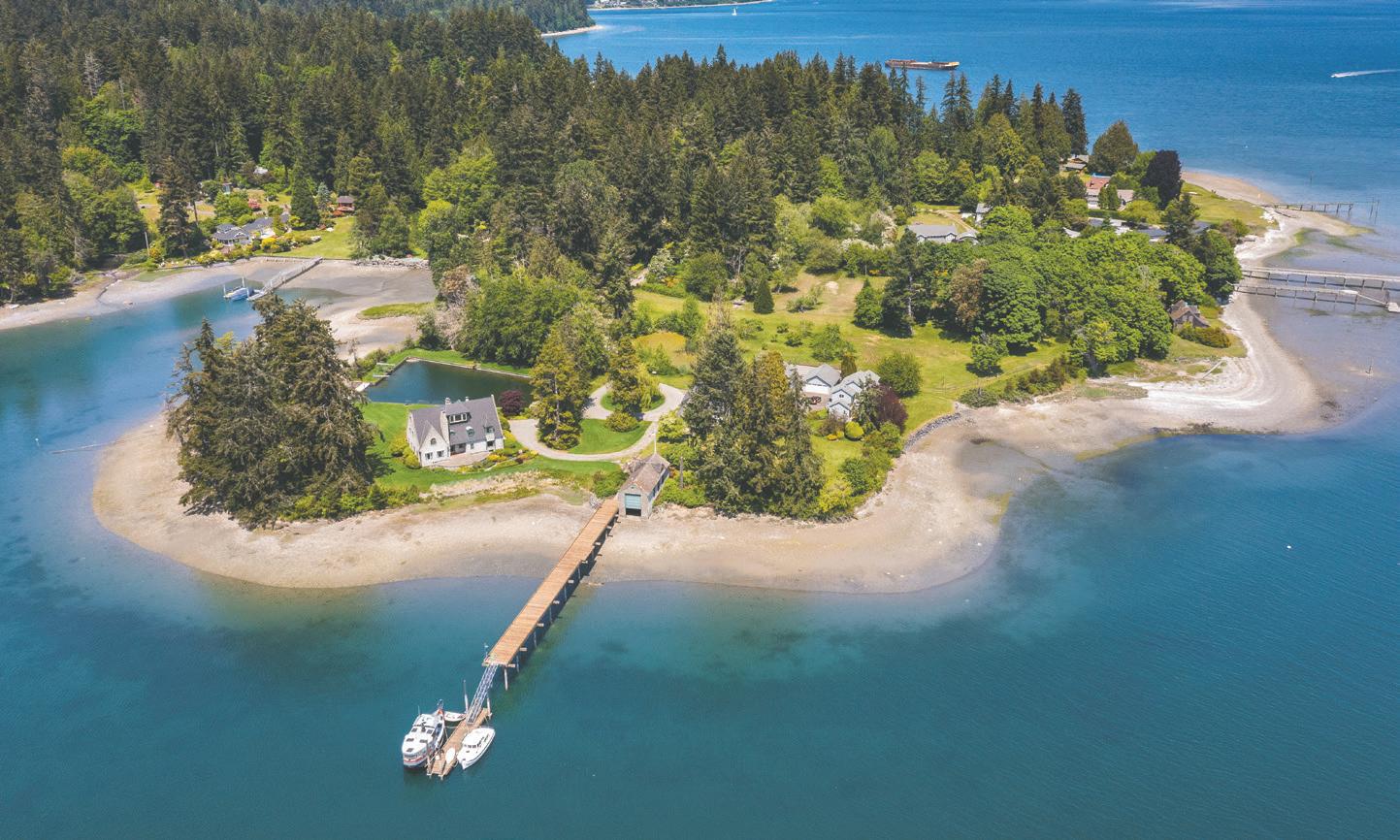









Fiscal Fallout: Washington ‘in the worst budget crisis
By TJ Martinell The Center Square
Last month, the state Economic and Revenue Forecast Council reported that Washington faced running out of money by 2027. With the passage of President Donald Trump’s One Big Beautiful Bill Act, the state now faces the loss of billions in Medicaid funding that could exacerbate Washington’s fiscal woes in the upcoming legislative sessions.
“We're in the worst budget crisis we've ever had,” Gov. Bob Ferguson’s Senior Health Policy Advisor Caitlin Safford told the Senate Health & Long-Term Care Committee at its Tuesday meeting.
The One Big Beautiful Bill Act enacts changes to Medicaid eligibility, which is expected to significantly reduce the number of Washington residents on the program, known in the state as Apple Heath. While Sen. Patty Murray, D-Wash., recently claimed 250,000 would lose coverage and cause more than a dozen hospitals to close, Health Care Authority Medicaid Director Charissa Fotinos told the Health & Long-Term Care Committee she estimated 100,000 would lose coverage.
While she said that “we can't say with any
MARKET
From page B1
Preparing to Buy or Sell: Strategic Advice
For buyers, preparation is essential. Get your financing in order—and consider going beyond pre-approval to full underwriting. This gives you an edge when competing with other buyers. Cash buyers should be ready with proof of funds, ideally in the form of a letter from a financial advisor rather

certainty how many people will lose coverage and how much money it will cost the state over the 10-year period,” she added that “the impacts will be significant.”
Safford said that “between a combination of federal rule, HR1 and the potential expiration of the enhanced advanced premium
than sensitive bank statements. Touring the market regularly and working closely with a seasoned broker will ensure you're well-informed and confident when it's time to act. Sellers, too, should begin preparations well in advance. Start with repairs, consider a pre- in-spection, and follow your agent’s guidance on decluttering, staging, and enhancing curb appeal. Your agent should also provide a thorough comparative market analysis, and importantly, walk you through
tax credits, we are going to start seeing coverage losses in January. That’s going to take an immediate hit to our uninsured rate. It'll be a hit to providers; we'll probably see some counties that don't have individual market coverage, which is going be really tough. There's going to be some tough decisions
similar active listings to align pricing expectations and market positioning.
The Value of Experience
Whether you're planning to buy or sell this year or are simply gathering information, working with an experienced, data-savvy broker is critical. Seek out someone who understands the nu-ances of the current market and who has navigated both upturns and downturns in past market conditions.
that are going have to made on the ground around how we're structuring our health care system.”
She also said that “from the Governor's Office, this from our perspective, this is a partnership we're going to be having with the Legislature on how we are accomplishing everything we have to accomplish. Likely a lot of that coming in the next 60-day short session and then whatever else we need to do in a 105-day’s session in 2027.”
Medicaid spending in Washington state has increased fivefold since 2013, when there were 1.3 million residents enrolled. Almost a decade later and after the program was expanded by the Affordable Care Act, there were there were 2.17 million residents enrolled in Apple Health. That program now includes an expansion for illegal aliens funded solely by the Legislature operating budget at a cost of $150 million for taxpayers.
Overall spending by the state Legislature has increased 116% since the 2013-15 biennium. After facing a budget shortfall in the billions of dollars despite record revenue levels due to increased spending, the Legislature passed the largest tax increase in state history.
As a longtime Madison Park resident and real estate broker with over two decades of experience, I believe deeply in the power of preparation, strategy, and long-term relationships. If you’re consid-ering making a move now or down the road, I’d be happy to connect confidentially and share the real-time data and insights that can help guide your decision-making.
Information and statistics derived from the Northwest Multiple Listing Service (NWMLS).








ADOBE STOCK















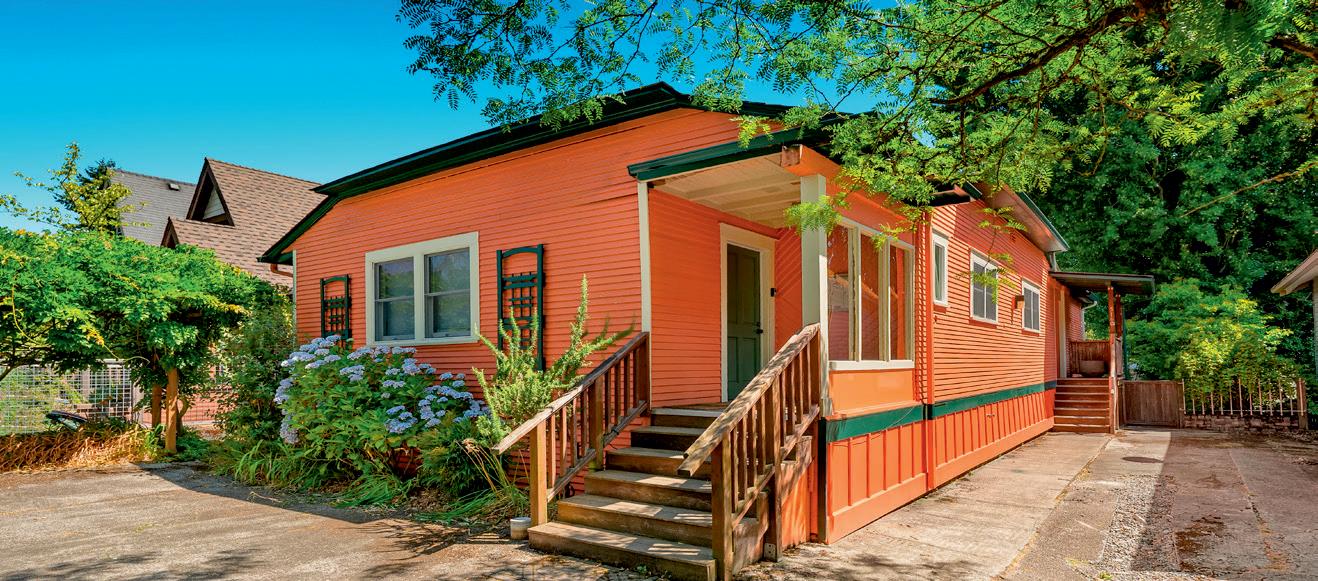



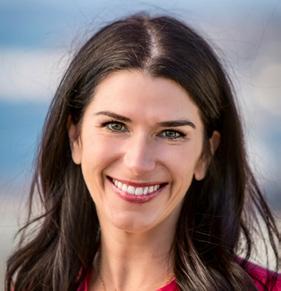


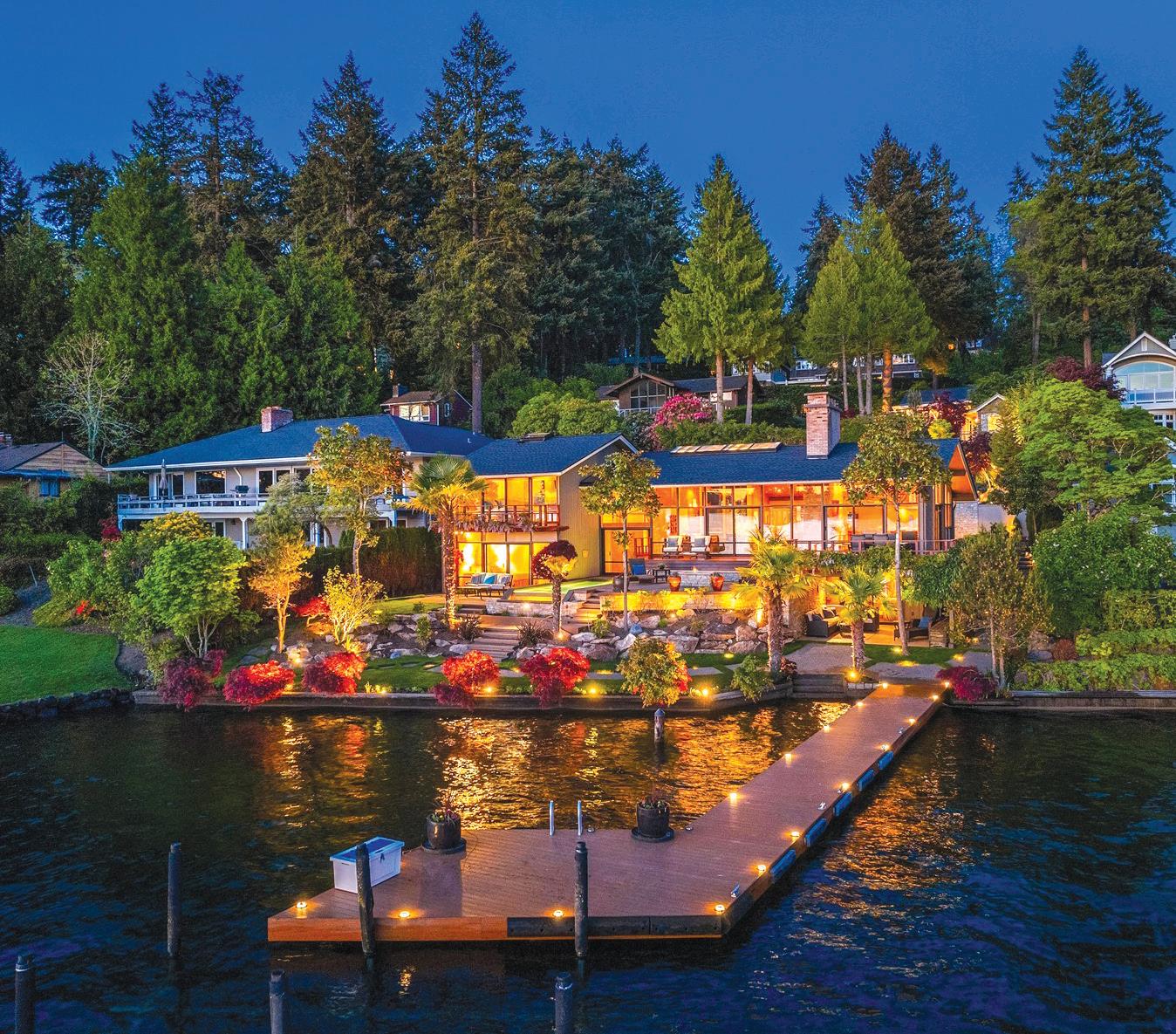



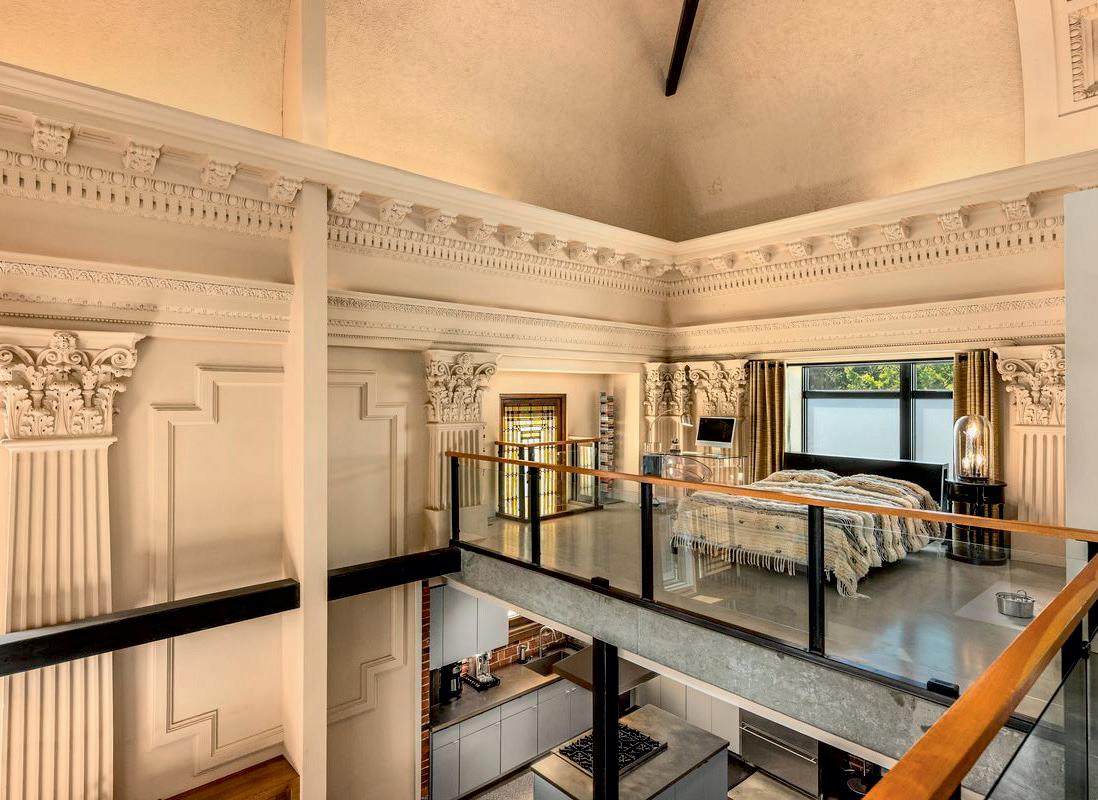










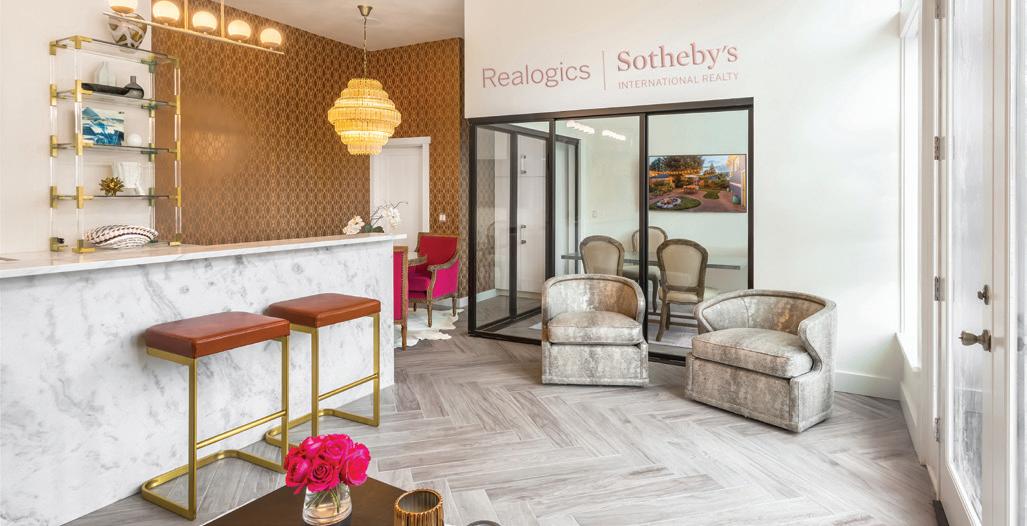
Seattle overspends on potholes as $2B road repair backlog lingers
By Spencer Pauley The Center Square
Seattle continues to overspend on filling potholes as the city’s backlog of roads that need fixing totals more than $2 billion.
In a presentation to the Seattle Transportation Committee, the Seattle Department of Transportation said that the city has a large backlog of unfunded paving needs, totaling $1.8 billion for arterial streets in need of reconstruction. In addition, the city currently has a backlog of $460 million worth of roads in need of rehabilitation.
However, SDOT Interim Division Director Elsa Tibbits notes that the city’s recent voter-approved $1.55 billion transportation

levy provides new funding for continuing pothole efforts. With the levy dollars, the city’s pothole



budget from 2025 to 2032 averages $41.25 million a year, or $330 million in total. That’s up from $250 million under the last levy.
“With the increased funding for our [Arterial Major Maintenance] crew paving projects – we can increase our response to stitch the areas of distressed street segments to extend the life for two to five years versus the 20 years of reconstruction,” Tibbits said during
the Transportation Committee meeting.
Seattle’s arterial streets have 1,153 lane miles of roads to maintain, with the city typically filling 15,000 to 25,000 potholes a year, according to Tibbits. Repairs cost about $152 per pothole, in addition to the conditions already outlined, other factors like material and labor costs influence the cost per repair.
Since 2020, SDOT’s expenditures on potholes have increased from $3.8 million in 2020 to a five-year-high of $5.68 million in 2022. Last year, the city spent approximately $5 million on repairing potholes.
Tibbits noted that expenditures on pothole repair have exceeded the budget consistently over the last five years. As a result, through the 2023 budget, SDOT was approved to add an additional $1.3 million in budget from the Seattle Transportation Benefit District Fund, backed by vehicle license fee revenues, to establish a higher baseline budget for pothole repair
going forward.
The city’s need exceeds the allocated budget, but SDOT is pointing to progress on its goal of responding to reports of potholes within 72 hours. The department is informed of any potholes through any reports made on the Find It, Fix It app.
Last year, 90% of reported potholes were filled within 72 hours of the report, according to SDOT.
Seattle City Councilmember Dan Strauss notes communication challenges he’s witnessing between the city and residents in regards to street repairs. In one case, an individual had repeatedly submitted complaints through the Find It, Fix It app for a significantly large pothole. But Strauss said the city never responded, because the hole did not fit into the city’s definition of a pothole.
“To a common person, they just see a hole in the road that’s going to mess up their axel,” Strauss said. “You’re out there doing good work, but we need to be better about communicating with the public.”

Starbucks return-to-office plan adds momentum to Seattle’s recovery
By Spencer Pauley The Center Square
Starbucks is ordering its corporate employees to move closer to the city and work in-person four days a week as the coffee giant is the next major Seattlebased company to make employees return to the office.



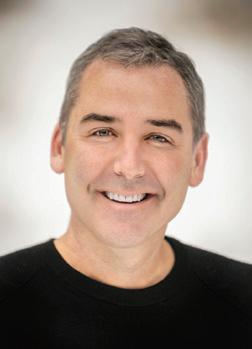
Starbucks CEO Brian Niccol recently sent a letter to employees that the company will require support center employees and managers to shift from a required three days in office to a minimum of four days in office starting in the upcoming fiscal year. This will apply to the company’s Seattle and Toronto support center employees.
In February, the company asked all of its corporate leaders to relocate to Seattle and Toronto offices. Niccol is now extending this requirement to all leadership positions within the company’s support centers. They will be expected to be based in Seattle or Toronto within 12 months.
In Niccol’s letter, he said working
in person helps the company strengthen its culture and “turn the business around.”
“We are reestablishing our in-office culture because we do our best work when we’re together,” Niccol said in the letter. “We share ideas more effectively, creatively solve hard problems, and move much faster.”
Starbucks’ headquarters are located in Seattle’s SODO neighborhood and just under two miles away from the downtown area. The company’s announcement points to a continuing progression of workers returning to Seattle’s commercial area.
This year, Amazon required its Seattle-based workers to return to working in-office five days a week. As a result, the downtown area has seen worker foot traffic reach 66% of June 2019’s daily average, according to data from the Downtown Seattle Association. That is the highest rate of monthly worker foot traffic recovered since March 2020 when the COVID-19 pandemic began.
The Center Square previously reported on Niccol being hired as the Starbucks CEO in August 2024, noting that he was not ordered to move to Seattle. At that time, Niccol avoided Washington’s 7% capital gains tax on the sale or exchange of long-term capital assets, such as stocks, bonds and business interests above $270,000.
However, since then, Niccol has both an office and residence in Seattle, according to Starbucks.
ADOBE STOCK
Seattle hails crime prevention tech pilot
By Spencer Pauley
The Center Square
Nearly two months after Seattle launched its crime prevention technology pilot program, city leaders are calling it a success with plans for expansion.
Since the Real-Time Crime Center, or RTCC, launched on May 20, it has been utilized to investigate 600 reported incidents across the city and is currently supporting 90 active criminal investigations.
Seattle Police Chief Shon Barnes said the center has exceeded his expectations.
“That’s real results and real impact – and we’re just getting started. We look forward to growing the RTCC in partnership with our city government partners, businesses, and the community.”
The RTCC software functions as a single access platform to view and analyze various sources of existing and proposed Seattle police data such as video and audio feeds, officer dispatch information and location, 911 calls, and police records.
Currently, RTCC cameras are being used along Aurora, Third Avenue, and the Chinatown-International District. Seattle Mayor

Bruce Harrell is proposing legislation to expand the cameras to the Garfield and Nova High Schools neighborhood, the Capitol Hill Nightlife District, and the SODO Stadium Area.
The legislation would also authorize the RTCC to view and record Seattle Department of Transportation's traffic cameras at select



intersections and along major arterial roads in the city.
The crime prevention pilot was approved by Harrell in October 2024. The city allocated $3.1 million toward the RTCC as part of its 2025-2026 budget.
In a press release, the city noted one recent example of RTCC being used for an investigation in which gun
violence occurred near Aurora Avenue North. RTCC analysts used CCTV cameras to observe the shooting suspect and send an image of the suspect to responding patrol officers. Analysts then advised officers of the escape route that the offender was taking.
Before the pilot program was approved, local


organizations voiced opposition of the technology with concerns that the use of the new surveillance technologies could allow for circumvention of Washington’s sanctuary protections, such as the Keep Washington Working Act and the Washington Shield law.
RTCC Commander and Seattle Police Captain James
Britt said the center is “conscious of the privacy concerns that technology can raise,” and that “our team is reminded at all times that we must use these systems responsibly.”
The RTCC currently operates daily from 8 a.m. to 3 a.m., with plans to expand to 24/7 in 2026.




Listed by Olga Dyckman with Windermere Midtown




